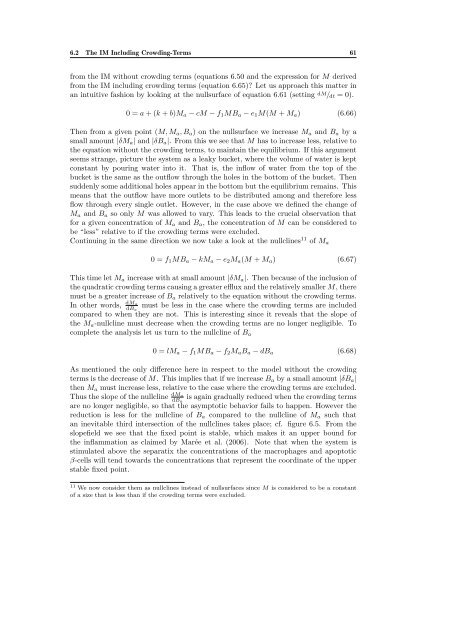nr. 477 - 2011 - Institut for Natur, Systemer og Modeller (NSM)
nr. 477 - 2011 - Institut for Natur, Systemer og Modeller (NSM)
nr. 477 - 2011 - Institut for Natur, Systemer og Modeller (NSM)
You also want an ePaper? Increase the reach of your titles
YUMPU automatically turns print PDFs into web optimized ePapers that Google loves.
6.2 The IM Including Crowding-Terms 61<br />
from the IM without crowding terms (equations 6.50 and the expression <strong>for</strong> M derived<br />
from the IM including crowding terms (equation 6.65)? Let us approach this matter in<br />
an intuitive fashion by looking at the nullsurface of equation 6.61 (setting dM/dt = 0).<br />
0 = a + (k + b)Ma − cM − f1MBa − e1M(M + Ma) (6.66)<br />
Then from a given point (M, Ma, Ba) on the nullsurface we increase Ma and Ba by a<br />
small amount |δMa| and |δBa|. From this we see that M has to increase less, relative to<br />
the equation without the crowding terms, to maintain the equilibrium. If this argument<br />
seems strange, picture the system as a leaky bucket, where the volume of water is kept<br />
constant by pouring water into it. That is, the inflow of water from the top of the<br />
bucket is the same as the outflow through the holes in the bottom of the bucket. Then<br />
suddenly some additional holes appear in the bottom but the equilibrium remains. This<br />
means that the outflow have more outlets to be distributed among and there<strong>for</strong>e less<br />
flow through every single outlet. However, in the case above we defined the change of<br />
Ma and Ba so only M was allowed to vary. This leads to the crucial observation that<br />
<strong>for</strong> a given concentration of Ma and Ba, the concentration of M can be considered to<br />
be “less” relative to if the crowding terms were excluded.<br />
Continuing in the same direction we now take a look at the nullclines 11 of Ma<br />
0 = f1MBa − kMa − e2Ma(M + Ma) (6.67)<br />
This time let Ma increase with at small amount |δMa|. Then because of the inclusion of<br />
the quadratic crowding terms causing a greater efflux and the relatively smaller M, there<br />
must be a greater increase of Ba relatively to the equation without the crowding terms.<br />
In other words, dMa<br />
must be less in the case where the crowding terms are included<br />
dBa<br />
compared to when they are not. This is interesting since it reveals that the slope of<br />
the Ma-nullcline must decrease when the crowding terms are no longer negligible. To<br />
complete the analysis let us turn to the nullcline of Ba<br />
0 = lMa − f1MBa − f2MaBa − dBa<br />
(6.68)<br />
As mentioned the only difference here in respect to the model without the crowding<br />
terms is the decrease of M. This implies that if we increase Ba by a small amount |δBa|<br />
then Ma must increase less, relative to the case where the crowding terms are excluded.<br />
Thus the slope of the nullcline dMa<br />
is again gradually reduced when the crowding terms<br />
dBa<br />
are no longer negligible, so that the asymptotic behavior fails to happen. However the<br />
reduction is less <strong>for</strong> the nullcline of Ba compared to the nullcline of Ma such that<br />
an inevitable third intersection of the nullclines takes place; cf. figure 6.5. From the<br />
slopefield we see that the fixed point is stable, which makes it an upper bound <strong>for</strong><br />
the inflammation as claimed by Marée et al. (2006). Note that when the system is<br />
stimulated above the separatix the concentrations of the macrophages and apoptotic<br />
β-cells will tend towards the concentrations that represent the coordinate of the upper<br />
stable fixed point.<br />
11 We now consider them as nullclines instead of nullsurfaces since M is considered to be a constant<br />
of a size that is less than if the crowding terms were excluded.
















